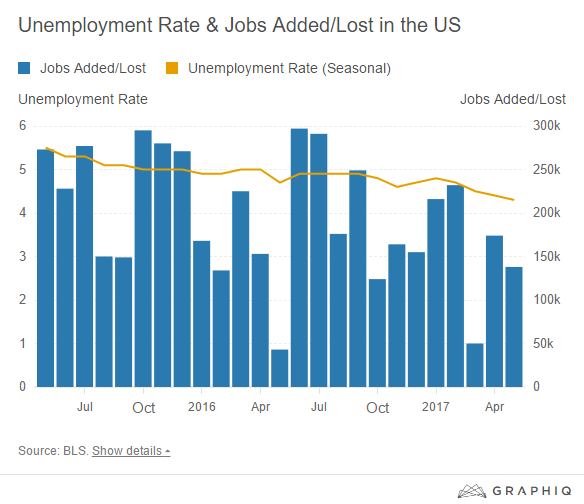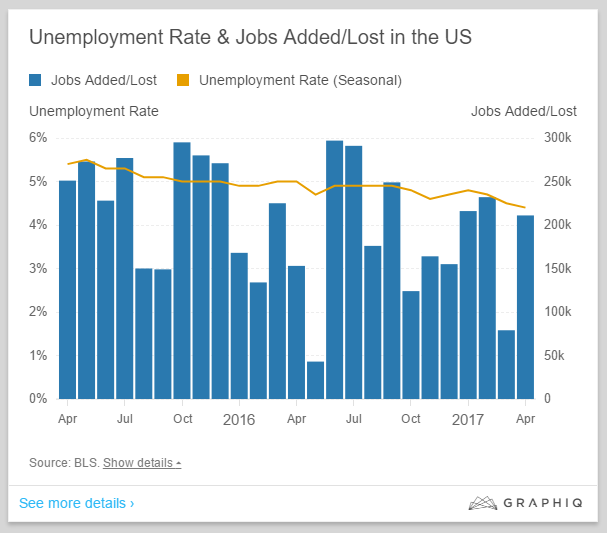2 million more jobs were created in 2017 as the US economy continues to hum along. The Labor Department Jobs Report shows the unemployment rate at 4.1% for the 3rd consecutive month. 148,000 jobs were added in December bringing the 3 month average to 204,000.
Manufacturing added almost 200,000 jobs last year, a turnaround from 2016, when it lost jobs. Construction added 210,000 jobs in 2017. Bars and restaurants hired about 250,000 waiters, cooks and hostesses. Health care continued to lead the pack, adding 300,000 jobs in 2017.
There were weak spots, though: Retail stores lost 67,000 jobs last year after several years of robust gains. Traditional stores are struggling, and some going out of business altogether, as more people shop online.
The number of Americans who are working part-time but want a full-time job is about 5 million, still above where it was before the Great Recession began in late 2007. That number has come down significantly since it peaked at 9.1 million in 2010. But these workers often are paid less, receive far fewer benefits like health care and are much more likely to live in poverty.
More broadly, the job market is shifting in a way that economists say helps explain why wage growth has been so sluggish. Shortly after the recession, employers and hiring managers could pick and choose employees because unemployment was so high. Eight years later, with unemployment at 4.1%, workers have the upper hand.
A record share of small business employers, 54%, say they found few or no qualified job applicants in December, according to a report published Thursday by the National Federation of Independent Business, an advocacy group for small employers.
If that trend continues, more companies will be forced to raise wages in a meaningful way to compete for workers.
Labor Report Unemployment Data
The number of unemployed persons, at 6.6 million, was essentially unchanged over the month. Over the year, the unemployment rate and the number of unemployed persons were down by 0.6 percentage point and 926,000, respectively. Among the major worker groups, the unemployment rate for teenagers declined to 13.6 percent in December, offsetting an increase in November.
In December, the unemployment rates for adult men (3.8 percent), adult women (3.7 percent), Whites (3.7 percent), Blacks (6.8 percent), Asians (2.5 percent), and Hispanics (4.9 percent) showed little or no change. Among the unemployed, the number of new entrants decreased by 116,000 in December. New entrants are unemployed persons who never previously worked. The number of long-term unemployed (those jobless for 27 weeks or more) was little changed at 1.5 million in December and accounted for 22.9 percent of the unemployed. Over the year, the number of long-term unemployed declined by 354,000.
The labor force participation rate, at 62.7 percent, was unchanged over the month and over the year. The employment-population ratio was unchanged at 60.1 percent in December but was up by 0.3 percentage point over the year. The number of persons employed part time for economic reasons (sometimes referred to as involuntary part-time workers) was essentially unchanged at 4.9 million in December but was down by 639,000 over the year. These individuals, who would have preferred full-time employment, were working part time because their hours had been cut back or because they were unable to find a full-time job
In December, 1.6 million persons were marginally attached to the labor force, about unchanged from a year earlier. (The data are not seasonally adjusted.) These individuals were not in the labor force, wanted and were available for work, and had looked for a job sometime in the prior 12 months. They were not counted as unemployed because they had not searched for work in the 4 weeks preceding the survey. Among the marginally attached, there were 474,000 discouraged workers in December, little changed from a year earlier. (The data are not seasonally adjusted.) Discouraged workers are persons not currently looking for work because they believe no jobs are available for them. The remaining 1.1 million persons marginally attached to the labor force in December had not searched for work for reasons such as school attendance or family responsibilities.
Contact Unemployment Tracker for information on effective Unemployment Insurance cost management.
.png?width=864&height=165&name=uet-2logos%20(1).png)




